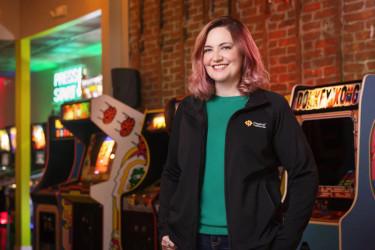
What do you do when you discover that your passion, the work you live for, has run dry, no longer fully satisfies you, but instead you have been seized by another passion? Ransom Wilson found himself at such a crossroads 30 years ago.
You remember Ransom Wilson? He was once a shooting star in the classical universe.
The Alabama-born flutist first won widespread attention in 1980 partly thanks to his album of Telemann & Bach Suites, with the Los Angeles Chamber Orchestra under Gerard Schwarz. Previously he had recorded two albums with his mentor Jean-Pierre Rampal, with whom Wilson studied privately for a year. He had also recorded an “Impressions” LP with harpist Nancy Allen, and a handful of disks from the mail-order Musical Heritage Society. With his first LACO record Wilson was being called “the heir apparent to Rampal.”
He set out straight away to fulfill such hopes & expectations by releasing what would become his most successful record, Pleasure Songs for Flute, with works ranging from Faure-Pavane to “Molly on the Shore,” from Ravel-Pavane to “Tomorrow Will Be My Dancing Day.” It was a perfect fit for classical music radio stations. All 20 tracks were short but of different lengths, good to fill any gap in programming, and each track was audience-core-center. On the cover, there was Ransom Wilson, casual in a sweater over his button-down, Mark-Spitz-handsome with some of the edges smoothed, looking like an older brother with his flute. The photo seemed to call out, “Call me Ransom.”

The Tuscaloosa native played everything. Mozart concerti with the London Symphony, and Mozart sonatas. Beethoven, Schubert & Schumann. Les Six. He cut a second record with LACO, a collection of baroque concertos, this one unique for its time, combining several scantily-known composers: Blavet, Tartini, Devienne & more. He played Ezra Laderman. He recorded well-received albums of music by vanguard composers such as Randall Woolf & Martin Bresnick. And while I was never anywhere at any radio station permitted to air it, I appreciated Ransom’s Koto Flute album as expressive and flawless, same as his other records. On the cover is a Japanese backdrop where on a folded blanket kneels Ransom wearing a black robe, his flute at the ready. His hair is perfect.
Entering his thirties, Ransom Wilson was surely on the designated path to the Rampal crown, but he had something his mentor did not have – a ceaseless urge to be on the podium. “I began conducting because I had to,” he told Ovation. “I just had to. I felt I had reached the end of the flute repertoire [and] there are few flute works that can claim any real depth. Why hadn’t I noticed this earlier? I was having a lot of fun.”
He eased off the accelerator on his solo flute career and began to study conducting. Among his teachers were the venerated music director at Stamford University in Connecticut Roger Nierenberg, and James Dixon, who led the Quad City Symphony in Davenport, Iowa, for nearly thirty years.
In the early-Eighties, Ransom founded his chamber orchestra Solisti New York. Now a maestro, the flutist poured energy into conducting as he had into his instrument. With Solisti New York, he produced a much-applauded LP of L’Histoire du soldat, and, thrillingly, the Adams-Reich record which became one of the first Minimalist LPs to break through into mainstream classical radio programming.
At 65 this October, an age often recognized, only a little sardonically, as the starting point for a symphony orchestra conductor’s career, Ransom Wilson the flutist most certainly has not put down his flute, but now he’s a conductor first. He’s led two productions at the New York City Opera, and for the last ten years has been on the musical staff at the MET as cover conductor.
Also in New York, one can find Ransom’s Le Train Bleu, an ensemble, or “unique musical collective,” which he founded & conducts with the mission to “explore new & interesting music.” A few years back, Le Train Bleu opened at Galapagos Art Space to raves and huzzahs. Ransom is also a longtime faculty member of the Yale School of Music, as professor of flute.
So you can see what a boon it is in the I.E. now that the world famous flutist has come to the Inland Empire as the new music director for the Redlands Symphony.
Maestro Wilson conducts all six subscription concerts in 2016-17. The first is October 8, on the Redlands’ U. campus, an all-Czech program: Smetana, Martinu, Dvorak.
And wadda I tell ya about Ransom and his flute? For the third concert of the season, January 21, 2017, an all-Mozart program includes one of the flute concertos. Guess who is the soloist.
Perhaps these days the desert winds are blowing melodically over the I.E., for in the same city, the Redlands Opera Theater is charting a bold course forward. The company is run by two singers: music director Christa Stevens, a lyric soprano who has toured with Andrea Bocelli and Keith Lockhart & the Boston Pops; and artistic director soprano Tiana Dye, a veteran of over thirty stage productions, who graduated from Redlands University with a Bachelor of Arts and a Master of Music degree.
Dye & Stevens will stage four productions, plus the season opening gala: Puccini’s one-act operas Suor Angelica and Gianni Schicchi in November, in which Lauretta is sung by seventeen-year-old super soprano Golda Berkman, a fast-rising star, having already made debuts at Walt Disney Concert Hall & Carnegie Hall.
At Christmastime, Redlands Opera Theater stages Gian Carlo Menotti’s Amahl and the Night Visitors; in the spring comes the Gilbert & Sullivan revue Trial by H.M.S. Pirakado, and the season closes with Bizet’s smoky tragedy Carmen.
All performances by the Redlands Opera Company take place in the 19th century Mission Gables overlooking the Redlands Bowl.
It may seem odd that the Redlands Opera Theater doesn’t collaborate much if at all with the Redlands Symphony. Well, the symphony is immersed in the symphonic rep, while the opera company does splendidly with the backing of other community orchestras, notably the volunteer Southland Symphony.
Founded only five years ago, the Southland Symphony is the brainchild & living, breathing organism of Dr. Sylvia Lee Mann, whose long trip took her away from L.A., and back again. After attending Chapman and USC, she concluded her studies in London, and once back in the States the job that came open for her was in the viola section of the Louisiana Symphony. Dr. Mann stayed put as principal for fifteen years, until 2002, when she returned to L.A. Today she is enmeshed with countless SoCal musical entities, including but not limited to: Unitarian Universalist Church of Studio City (director of music), the Bellflower Symphony Orchestra (assistant conductor), and the Beach Cities Symphony, Golden State Pops Symphony, and the Culver City Symphony Orchestras (principal violist). Dr. Mann also conducts or plays viola with the Cal State University Dominguez Hills Orchestra, the San Gabriel Valley Symphony, Coachella Valley and Inland Valley Symphony, and the Southland Rainbow Chorale. She is Minister of Music at Bethel Congregational Church in Ontario, and frequently plays with the La Mirada Symphony, the Chamber Orchestra of the South Bay, and the Rio Honda Symphony.
It’s a full plate for any musician, but Sylvia Lee Mann has shown herself up to the task where it comes to the Southland Symphony, the community orchestra that could. The Southland Symphony’s season is of similar length to Redlands’, with a “Tribute to Democracy” concert October 23, at Bethel UCC.







